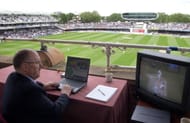In the early 2000s, Channel Nine was not concerned about the efficacy of the Snickometer. At the same time they happened to chance upon a technology founded by French scientist Nicholas Bion, which was being developed further by many Parisian companies.
The technology involved the use of infra-red cameras to sense and measure heat from friction generated by collision which would then generate a series of negative frames on a computer using a subtraction technique to locate the point of collision.
The ‘Hot Spot’ technique was used by the military to track tanks and jet fighters but apparently, Channel Nine thought that they could put it to better use in cricket, and hence they bought it out. They used the technology for the first time in the Gabba Test of the 2006-07 Ashes.
The 2008 season saw the launch of the inaugural IPL. It was an immediate success, and now more money was expected to be riding on the game of cricket. The ICC was also looking to expand the game in more countries and, for that, they needed a system to convince the onlookers that the game was as fair as it possibly could be.
In the winter of that year, they trialled the Hawkeye as a part of their future Decision Review programme. If a team disagreed with an LBW decision, they could ask the on-field umpire to raise the question to the third umpire who would be able to look at what the ball did up to the point it actually hit the batsman, but not beyond that.
Six months later, deeming that the Snicko was not accurate enough, they validated the use of Hot Spot for player trials during the Test series between Australia and South Africa in South Africa.
On the 24th of September 2009, the ICC rolled out the Umpire Decision Review System (UDRS or DRS) during the Dunedin Test match between New Zealand and Pakistan. The UDRS included an allowance to make two unsuccessful review requests per innings during a Test match (and one during a One-Day International) for each team.
The ICC had initially planned to make it mandatory for all international matches but was coerced by the BCCI to leave it to the teams involved to mutually agree on DRS. However, it is mandatory for all ICC events.
The response has generally been positive, but a few observers have felt it was more of a gimmick and undermined the authority of the on-field umpires. India is a vocal critic of the system, labelling it as an adulteration of human decision and technology instead of being completely one of the two.
The DRS is still very much a work in progress as the recent amendments on the LBW protocols last year show.
While the Hot Spot is assumed to be 90-95% accurate, doubts remain over the Hawkeye as well as the number of review requests which should be given to a team.
Nevertheless, the DRS is a significant milestone in the history of the game. With the use of a third umpire, the ICC accepted the use of technology for the game, and with the DRS they have embraced it more so. One just hopes it does not reach a point where they become overly dependent on it.
Read more about such events which altered the way cricket was played over the years – The moments that changed cricket forever.
Follow IPL Auction 2025 Live Updates, News & Biddings at Sportskeeda. Get the fastest updates on Mega-Auction and cricket news

